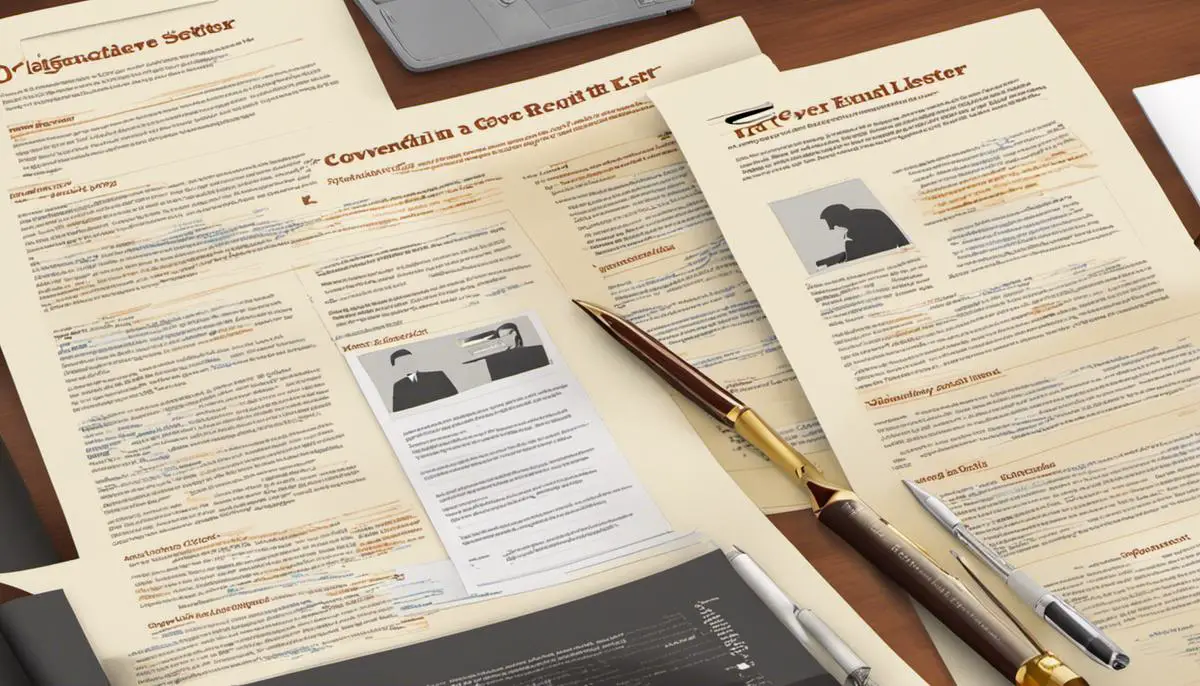Commanding a prospective employer’s attention during your job application process is paramount, and the key to achieving this is through a compelling cover letter. The ubiquity of resumes makes it necessary to go an extra mile – to craft a cover letter that markets you as an exclusive candidate suited for a particular role.
At its core, a cover letter showcases your professional demeanor, enlightens on your experiences, skills and qualifications, all in a captivating manner. But crafting such a cover letter isn’t enough, it’s the polishing – the editing – that makes your cover letter outshine others.
Understanding the Purpose of a Cover Letter
The Essence of a Cover Letter
A cover letter is an essential part of job applications. It serves as a letter of introduction that outlines your goal, which is to get the job and highlights the skills, experiences, and qualifications that make you the ideal candidate for it. It’s more than just adding a touch of personalization to your application; it’s your signature marketing tool.
Notably, a cover letter is the first point of direct communication between you and potential employers. It is where you make your first impression – and as we all know, first impressions count. It’s your chance to sell your skills, experiences, knowledge, and aspirations in the way that a resume or CV, with its bulleted, impersonal presentation, can’t.
Cover Letter as Your Marketing Tool
Consider your cover letter as a sales pitch to potential employers. It’s designed to market you as the best candidate by succinctly summarizing your qualifications, skills, and experiences relevant to the role you’re applying for. This is where your analysis of the job description plays a role. By understanding the needs of the employer, you can tailor your cover letter to address those needs using your unique capabilities.
Editing Tips for Your Cover Letter
- Use a Professional Tone: Keep the language and tone formal and professional throughout your cover letter.
- Keep It Brief: Potential employers often sift through countless applications. Making your cover letter concise and to the point increases your chances of it being read. Aim for no more than one page, with three to four paragraphs.
- Tailor to the Job: Ensure your cover letter matches the job you’re applying for. Highlight the skills and experiences that directly relate to the position.
- Highlight Achievements: Rather than just listing your experiences, point out what you achieved during each experience or role.
- Proofread and Edit: Mistakes and typos reflect poorly on you as a candidate – they may imply a lack of attention to detail. Make sure to thoroughly proofread your cover letter, and consider having a friend or family member review it as well.
Pitfalls to Avoid
- Repetition: Don’t simply repeat what’s in your resume. Use your cover letter as an opportunity to provide more depth and personality than a resume allows.
- Generic Statements: Avoid generic or fluffy statements. Be precise about your skills and qualifications. Use concrete examples to back up any claims you make about your abilities.
- Negative Language: Keep the language positive. Don’t mention what you don’t know or lack but instead, focus on what you bring to the table.
Effectively Communicating Your Professional Identity through Your Cover Letter
In essence, your cover letter should serve as a platform for illuminating your professional identity. This means expressing that unique synthesis of skills, experiences, and personal attributes that make you the perfect candidate for the job. By thoughtfully crafting your cover letter and diligently editing it to avoid common pitfalls, you can devise a compelling argument on why you’re the ideal choice for the role.

Key Elements of a Great Cover Letter
Decoding the Art of Cover Letter Editing
To truly latch onto the game-changing potential of a stellar cover letter, it is crucial to decode its structure and understand the formatting necessities. A well-conceived cover letter is typically composed of three to four paragraphs. These paragraphs passionately lay out your qualifications, exude your enthusiasm for the role, highlight relevant personality traits, and pinpoint the essential skills you possess that align seamlessly with the job requirements.
The First Paragraph: Introduction
Your cover letter should start with a compelling introduction. Here, specify the role you are applying for, how you found out about it, and briefly present your background. Keep this part precise but intriguing to encourage the reader to continue reading. When editing, ensure the introduction is specific to the company and role, rather than a generic statement that could apply to any job.
The Second Paragraph: Showcasing Your Skills
It is in this section that you demonstrate your qualifications, highlighting your skills that are most relevant to the job description. Provide solid examples, but don’t reiterate your whole resume. Instead, use this opportunity to tell a story about how successfully you employed such expertise in your previous role. When editing, re-read the job description to make sure the abilities you’ve included, and the examples you’ve shared genuinely align with what the employer is looking for.
The Third Paragraph: Demonstrating Your Interest
This part emphasizes your enthusiasm towards the company and the role. Showcase your knowledge about the company and explain why you are interested in the position. This display of initiative and dedication can differentiate you from other candidates. While editing, ensure this part appears personalized and genuine, not a copy-pasted passage fitting any company.
The Final Paragraph: Closing and Call to Action
The close should be a brief summary reminding the reader about your qualifications and expressing your willingness to discuss your application in an interview. Accordingly, incorporate a call to action, like looking forward to an interview opportunity or intending to follow up in a specified period. During editing, ensure this section includes your contact information and a thank-you note.
Tone and Language of the Cover Letter
A cover letter must be professional yet conversational in tone. It should reflect your character and be written in the first person, avoiding excessive jargon or unnecessary complex sentences. Remember, your goal is to communicate clearly, not to impress with big words.
Striking a balance between showcasing your expertise and remaining humble is crucial. While it’s essential to show confidence in your abilities, avoid coming off as arrogant. When describing accomplishments, focus on your role and the impact you made rather than merely listing awards or accolades.
Grammar, Spelling, and Punctuation Checks
One of the most essential cover letter editing tips involves proofreading for grammar, spelling, and punctuation errors. Even one typo can give off an impression of carelessness, affecting your chances of gaining the job. So, double-check all elements of your cover letter, and consider having another person review it for a fresh perspective.
As an essential step to ensuring the highest standards in your cover letter, editing allows you to refine your work and provides an opportunity to leave a lasting impression. Without fail, it can significantly increase your chances of securing an interview.

Top Cover Letter Editing Tips
First Step in Cover Letter Editing: Proofreading for Grammar and Spelling Errors
Initiating the editing process with thorough proofreading is key. Misspelled words and grammatical mistakes could lead employers to believe you lack an important skill: attention to detail. To avoid committing these errors, it is advised to invest adequate time in meticulously examining your cover letter.
Consider getting assistance from grammar and spell check tools such as Grammarly or Microsoft’s Spell Check for a preliminary review. However, do not rest your case solely on the results from these tools, as some finer errors may be overlooked. For a more robust review, try reading your cover letter aloud or asking someone else to go through it.
Cover Letter Editing Step 2: Ensuring Consistency in Tense and Pronouns
Consistency is key in your cover letter. If you’re speaking in the past tense, ensure it’s maintained throughout. Switching tenses can make your letter confusing.
The same rule applies to pronouns. If you start off with third-person point of view, stick with it until the end. Consistency helps your cover letter to flow better, becoming more effective and influential.
Cover Letter Editing Step 3: Checking for Clarity and Brevity
Recruiters often skim through cover letters due to time constraints, so clarity and brevity are vital. Avoid jargon or complicated phrases. Use simple and straightforward language that anyone can understand.
Keep your sentences short and organized. Each paragraph should contain one main idea, and each sentence should contribute to this idea.
Cover Letter Editing Step 4: Tailoring Your Cover Letter to Each Job
A generic cover letter will not stand out among the hundreds of applications employers receive. Tailoring your cover letter to the specific role shows your interest and effort.
Research the job and company, then highlight how your skills and experiences match what they’re looking for. Do not merely repeat your resume; instead, use your cover letter as an opportunity to provide context or delve deeper into key experiences on your resume.
Step 5 of Cover Letter Editing: Ensure Inclusion of Essential Details
Start by confirming your cover letter is complete with requisite information. It’s vital to feature your contact details, the date, and the recipient’s information at the top. The main content of your cover letter should follow, consisting of an engaging introduction, a succinct body portraying your qualifications, and a compelling conclusion.
Finally, don’t forget to include attachments like your resume and other necessary documents as part of your application requirements.

Common Cover Letter Mistakes to Avoid
Steer Clear of Generalizations
A frequent error during the cover letter composition process is resorting to a generic, one-size-fits-all message. Quite often, applicants use the same cover letter for every job that they apply for, merely altering the company and the job title. This strategy can come off as monotonous and reflects a lack of effort or genuine interest in the job. Therefore, it’s paramount to tailor your cover letter to match each distinct job application and company you’re addressing.
Customize your Cover Letter
Employers value originality and sincerity. Therefore, generic phrases and templates can cause your application to go unnoticed. Instead, your cover letter should be tailored as per the job you’re applying for. It should highlight relevant experiences and skillsets that align with the job descriptions and requirements set out by the employer. Make sure to use key phrases from the job posting itself, but also make your own insights on how your skills and experiences can benefit the company.
Proofread to Catch Typos
Regardless of how confident you are in your typing skills, never submit your cover letter without proofreading it first. In addition to catching grammar and punctuation errors, proofreading allows you to check your sentence structure, eliminate redundancies, and ensure your message is clear and concise. A cover letter with typos and grammatical errors can create an impression of carelessness and lack of attention to detail, traits that are unlikely to impress a potential employer.
Remove Irrelevant Information
The purpose of a cover letter is to convince the employer that you’re the best candidate for the job. As such, only the most relevant information should be included. Avoid including irrelevant details about your personal life, and focus solely on your professional experience, skills, and qualifications. Remember that hiring managers are typically limited in time, so your cover letter should not exceed a page. Supplement your resume, highlighting key experiences and attributes, rather than reiterating everything mentioned in your resume.
Avoid Negative Statements
Your cover letter should focus on your positive attributes. Avoid self-deprecating remarks, and don’t provide a list of skills you don’t possess. Instead, focus on the skills and experiences you do have that make you a strong candidate for the job. Even when discussing challenges or shortcomings, try to frame them in a way that highlights your ability to learn and grow.
Use Appropriate Tone and Language
Remember, a cover letter is a professional document. Therefore, it should be written in a formal, professional tone. Avoid using slang, jargon, or overly complex language. You need to strike a balance between showcasing your personality and maintaining the professionalism that employers expect. An effective cover letter is one that is clear, concise, and relevant, and that successfully highlights your suitability for the job.

Undeniably, recognizing the critical role played by a cover letter is the initial step towards propelling your suitability for a job application. Subsequent steps involve structuring it impeccably, integrating all focused and salient points, and editing it finely to ensure it’s void of common errors. The end product is a spotlight that focuses on your credentials exclusively, drawing the attention of the hiring manager right to you. To miss out on any of these elements is to cast a shadow upon your application. Embracing these instructions doesn’t make job applications easier; rather, it makes you a tougher competitor in the job market, increasing your chances of securing your desired job.

